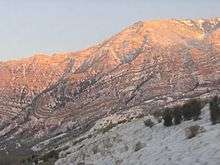Syncline
.png)
In structural geology, a syncline is a fold with younger layers closer to the center of the structure. A synclinorium (plural synclinoriums or synclinoria) is a large syncline with superimposed smaller folds.[1] Synclines are typically a downward fold, termed a synformal syncline (i.e. a trough); but synclines that point upwards can be found when strata have been overturned and folded (an antiformal syncline).
Characteristics
On a geologic map, synclines are recognized as a sequence of rock layers that grow progressively younger, followed by the youngest layer at the fold's center or hinge, and by a reverse sequence of the same rock layers on the opposite side of the hinge. If the fold pattern is circular or elongate circular the structure is a basin. Folds typically form during crustal deformation as the result of compression that accompanies orogenic mountain building.
Notable examples
- Powder River Basin, Wyoming, US
- Sideling Hill roadcut along Interstate 68 in western Maryland, US, where the Rockwell Formation and overlying Purslane Sandstone are exposed.
- Western Lake Superior, which occupies a basin created by the Midcontinent Rift System
- Saou, a commune in the Drôme department in southeastern France
- The Catlins, an area in the southeastern corner of the South Island of New Zealand
- Strathmore, Angus Syncline, Scotland
Gallery
 Syncline exposed in Sideling Hill roadcut
Syncline exposed in Sideling Hill roadcut Snow-dusted syncline in Provo Canyon, Utah.
Snow-dusted syncline in Provo Canyon, Utah.- Road cut near Fort Davis, Texas showing a syncline.
- Syncline in the lower parking lot of Calico Ghost Town; note ductile folding at base, brittle above.
 Synclinal fold in Silurian Wills Creek Formation or Bloomsburg Formation at Roundtop Hill (Maryland)
Synclinal fold in Silurian Wills Creek Formation or Bloomsburg Formation at Roundtop Hill (Maryland) East wall of Bear Valley Strip Mine, near Shamokin, Pennsylvania
East wall of Bear Valley Strip Mine, near Shamokin, Pennsylvania
See also
- Anticline
- Homocline
- Monocline
- Ridge-and-valley Appalachians –With good bird's eye photo of a range of the types
References
- ↑ Synclinorium. (2008). In Encyclopædia Britannica. Retrieved May 03, 2008, from Encyclopædia Britannica Online: http://www.britannica.com/EBchecked/topic/578375/synclinorium